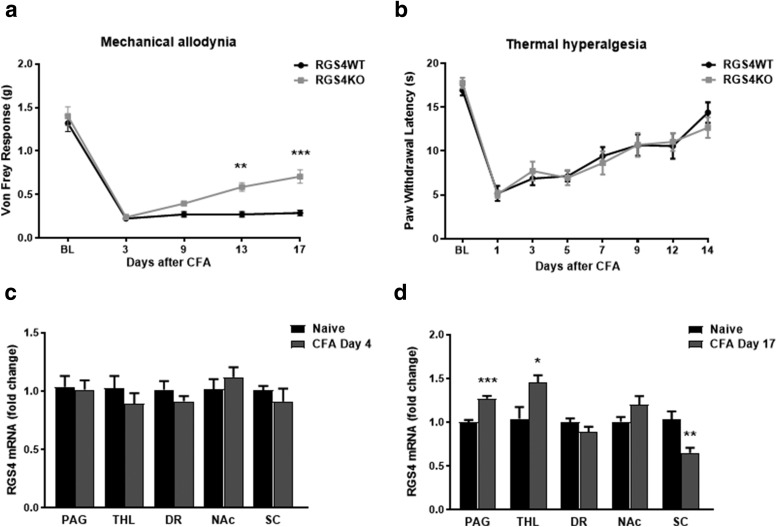Figure 1.
RGS4KO mice rapidly recover from mechanical allodynia in a model of long-term peripheral inflammation. a, Male RGS4WT and RGS4KO mice show mechanical allodynia in the Von Frey assay in response to CFA injection to the left hindpaw, but RGS4KO mice recover by day 13 (two-way ANOVA followed by Bonferroni post hoc tests: F(1,28) = 16.39, **p = 0.001, ***p < 0.001; n = 15). b, RGS4KO mice show identical responses to their RGS4WT controls in the Hargreaves assay of thermal hyperalgesia (two-way ANOVA: F(1,20) = 0.0009, n = 11/group). c, qPCR analysis reveals that RGS4 mRNA expression in the PAG, THL, DR, NAc, and ipsilateral SC does not change at early time points (4 d) after the induction of peripheral inflammation (CFA injection to the left hindpaw). Unpaired t test: PAG, t(20) = 0.1893; THL, t(9) = 0.966; DR, t(10) = 1.153; NAc, t(10) = 0.8572; SC ipsilateral, t(18) = 0.8891; n = 5–11/group; for all comparisons, p > 0.05). d, At later time points (17 d post-CFA), there is an increase in Rgs4 transcript in the PAG and in the THL (unpaired t test: PAG: t(11) = 6.629, ***p < 0.001, n = 6–7/group; THL: t(10) = 2.64, *p = 0.02, n = 6/group; DR: t(11) = 1.521, n = 6–7/group, NAc: t(13) = 1.778, n = 7–8/group; SC: t(24) = 3.604 **p = 0.001, n = 13/group).

